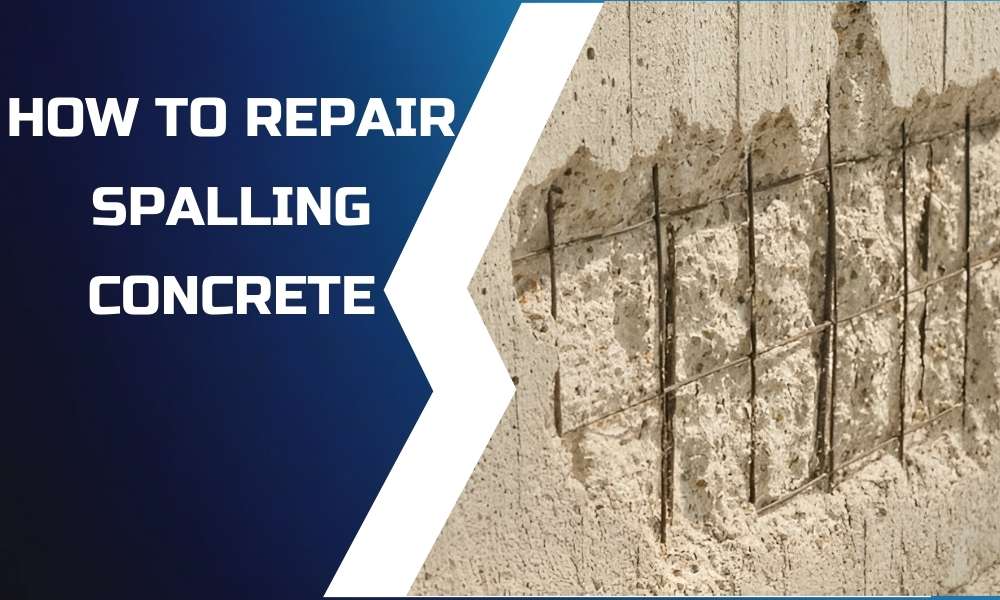Spalling concrete is a common problem where the surface of concrete begins to flake, chip, or crumble, often revealing the inner layers or reinforcing steel. This type of concrete surface damage not only looks unsightly but can also compromise the strength and safety of the structure if not addressed promptly. Ignoring the issue can lead to more extensive—and expensive—repairs over time. That’s why it’s important to Repair Spalling Concrete as soon as signs appear. In this guide, we’ll explain what spalling concrete is, why immediate concrete repair matters, walk you through a step-by-step repair process, and share tips to prevent future damage.
Tools and Materials Needed for Repair
- Safety gear
- Hammer and chisel
- Wire brush or grinder
- Concrete bonding agent
- Patching compound or resurfacer
What Is Spalling Concrete?
Spalling concrete refers to the flaking, chipping, or crumbling of the concrete surface, often exposing the aggregate or reinforcing steel beneath. A spalled concrete surface typically appears rough, pitted, or broken, and can worsen over time if left untreated. This type of damaged concrete surface is commonly caused by freeze-thaw cycles, corrosion of reinforcing steel (rebar), poor finishing techniques, or the use of low-quality materials. You’ll often find spalling on horizontal surfaces such as driveways, sidewalks, patios, garage floors, and basement slabs—areas exposed to moisture, temperature changes, or heavy wear. Understanding what spalling is and recognizing the early signs can help you take timely action to prevent more serious structural damage.
Why It’s Important to Repair Spalling Concrete
Repairing spalling concrete is crucial not only for appearance but also for safety and long-term durability. Left untreated, concrete deterioration can compromise the structural integrity of the surface, especially if it exposes and weakens the reinforcing steel inside. This can lead to cracks, crumbling, and even serious foundation issues over time. Visually, spalled concrete creates an unsightly, worn look that can reduce the value of your property. Moreover, the longer you wait to address the issue, the more extensive—and expensive—the repairs can become. Acting quickly helps you prevent further damage, maintain your property’s value, and avoid costly future repairs.
Step-by-Step Guide to Repair Spalling Concrete
Follow these simple concrete repair steps to fix a spalled concrete surface and restore its strength and appearance:
Step 1: Inspect the Area
- Examine the concrete to assess the extent of the spalling.
- Check for any cracks, deep pits, or exposed rebar that may indicate structural issues.
- If the damage is extensive or affects structural integrity, consult a professional.
Step 2: Prepare the Surface
- Use a hammer and chisel or grinder to remove all loose, flaking, or crumbling concrete.
- Clean the area thoroughly with a wire brush and water to remove dust, dirt, and debris.
- Let the surface dry, then apply a concrete bonding agent if required by your repair product. This ensures better adhesion of the new material.
Step 3: Apply Repair Material
- Mix your chosen patching concrete compound or resurfacer according to the manufacturer’s instructions.
- Apply the material to the damaged area using a trowel, making sure it fills all cracks and voids.
- Smooth the surface evenly and allow it to cure as directed—this may take several hours or more depending on the product.
Step 4: Finish and Seal
- Once the patch has fully cured, consider applying a concrete sealer to protect the surface from moisture, freeze-thaw cycles, and salt damage.
- Follow the manufacturer’s instructions for sealing and curing times.
- Regular maintenance and sealing can help prevent future spalling and prolong the life of your repair.
Preventing Future Spalling
Once you’ve repaired the damage, it’s important to take steps to prevent concrete spalling from happening again. Start with regular maintenance—clean your concrete surfaces often to remove debris, moisture, and harmful chemicals. Applying a high-quality concrete sealer creates a protective barrier against water, freeze-thaw cycles, and corrosive agents like de-icing salts. Ensure proper drainage around concrete areas to avoid standing water, which can accelerate deterioration. Also, try to minimize heavy impacts or pressure, especially in areas like driveways and sidewalks. By following these simple tips, you can effectively protect concrete surfaces and extend their lifespan.
When to Call a Professional
While many cases of spalling can be handled with DIY methods, some situations require professional concrete repair. If you notice deep cracks, widespread crumbling, or structural concrete damage such as exposed or corroded rebar, it’s best to call in an expert. A qualified contractor can assess the underlying cause, ensure the damage isn’t compromising the structure, and apply the right repair techniques for long-lasting results. Hiring a concrete repair specialist also saves time and ensures the job is done safely and correctly—especially when dealing with load-bearing surfaces or large-scale damage.
Read more: How to Repair Large Cracks in Concrete Driveway
Conclusion
Spalling concrete may start as a minor surface issue, but if left untreated, it can lead to serious structural problems and costly repairs. As we’ve covered in this guide, knowing how to Repair Spalling Concrete involves inspecting the damage, preparing the surface, applying the right materials, and finishing with proper sealing and maintenance. Acting quickly not only restores the look of your concrete but also preserves its strength and longevity. Don’t wait until the damage worsens—address it early and take steps to prevent it from recurring. Don’t let spalling concrete get worse—follow these steps to restore and protect your surfaces today!

